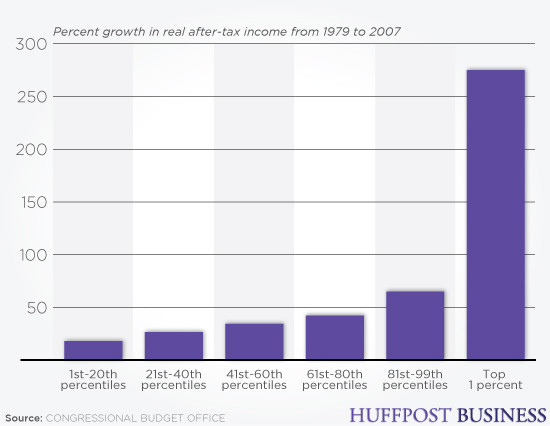WASHINGTON -- America's 99 percent are not just imagining it. The gap between the incomes of the rich and poor in this new Gilded Age is strikingly broad and deep, according to an October report from Congress' data crunchers.
The study by the Congressional Budget Office, released this week, found that income has become dramatically concentrated, shifting heavily toward the top earners between 1979 and 2007.
And although incomes at all levels have risen some, they've skyrocketed for the very wealthiest of earners.
At the other end of the scale, Americans in the bottom fifth of earners saw their incomes increase by less than 20 percent across the nearly three decades. Incomes for those in the middle 60 percent climbed by less than 40 percent over the same span.
Things start to look especially good for the top fifth of earners, who saw their cash flow jump by 65 percent.
But it's among the top 1 percent where the growth was breathtaking. That contingent saw their incomes spike by 275 percent.
"It is really stunning the degree to which rewards have been concentrated at the top," said Josh Bivens, an economist at the left-leaning Economic Policy Institute. "We have now returned to Gilded Age levels of inequality."
The CBO report revealed some other stark facts. While incomes did rise up and down the ladder, the explosive growth for the top 1 percent so vastly outweighed the expansion further down that the top 1 percent's share of the nation's total income more than doubled to just over 20 percent.
The hoarding at the top was so great that even after accounting for taxes, the "income received by the 20 percent of the population with the highest income exceeded the aftertax income of the remaining 80 percent," the CBO found.

This week's report is far from the first to point out rising income equality in the United States. Numerous studies have shown that America's very highest earners have been steadily pulling away from the rest of the population for a generation.
Wages for the lower and middle classes have hardly moved for the last three decades -- a phenomenon that roughly coincides with the decline in union participation, as Think Progress noted. Paul Krugman, the Nobel-winning economist and left-leaning New York Times columnist, describes this phenomenon as the "Great Divergence."
Today, the 400 richest people in the country control more wealth than the bottom 50 percent of households, and the U.S. ranks roughly alongside countries like Uganda, Cameroon, Ecuador and Rwanda in terms of the gap between its richest and poorest citizens.
The CBO report did not entirely explain why the gap has expanded, but noted that salaries for "superstars" -- top earners in sports, entertainment and the corporate world -- have jumped out of proportion to other workers' income. The report also noted that capital gains income has spiked much more than cash coming from interest, dividends or pensions.
But even the surge in top-level compensation doesn't explain all the growing disparity. "Without that growth at the top of the distribution, income inequality still would have increased, but not by nearly as much," the CBO said.
And none of that explains what has driven those trends.
For Bivens, they're the result of 30 years of conservative-leaning policies that have undermined unions, left the minimum wage lower (adjusted for inflation) than it was in the '60s, and favored financiers and corporations over laborers.
A big culprit is the deregulation of the finance industry, said Bivens, noting that the CBO identified finance as a sector that saw some of the largest jumps in income. "That sector has just taken a larger and larger share of the economy, while producing a, shall we say, dubious return," Bivens said.
The year 2007 has a lot in common with another notable year: 1929. Besides the similar spikes in glaring income inequality, both years marked the beginning of one of the worst economic downturns in United States history.
Bivens could not say with any certainty that economic crashes can be blamed on high levels of inequality, but he said that with so few people holding so much of society's resources while so many others scramble to maintain decent lifestyles, the economy has little cushion when bubbles, such as the housing market, pop.
According to the International Monetary Fund, the pronounced degree of inequality today is likely holding back the economic recovery -- thereby prolonging the misery for millions of Americans who are out of work and the record 46.2 million who are currently living in poverty.
Regardless of any linkages between income inequality and the broader economy, Bivens argues that it just isn't good.
"It just strikes me as obviously unfair," he said. "You cannot convince me that the increases in the top 1 percent is a return to some meritocracy."
The gap separating the richest 1 percent from the rest of the country has emerged as arguably the single most prominent rallying cry of the Occupy Wall Street movement, which began last month in New York City's Zuccotti Park and has since expanded to hundreds of protests around the country and sister demonstrations across six continents.
And there's another coincidence that Occupy Wall Street and the 99 percenters might point out: It was the collapse of the Gilded Age that preceded many of the successes of the labor movement and the left.
This article expands on an earlier version by Alexander Eichler published Wednesday afternoon.
